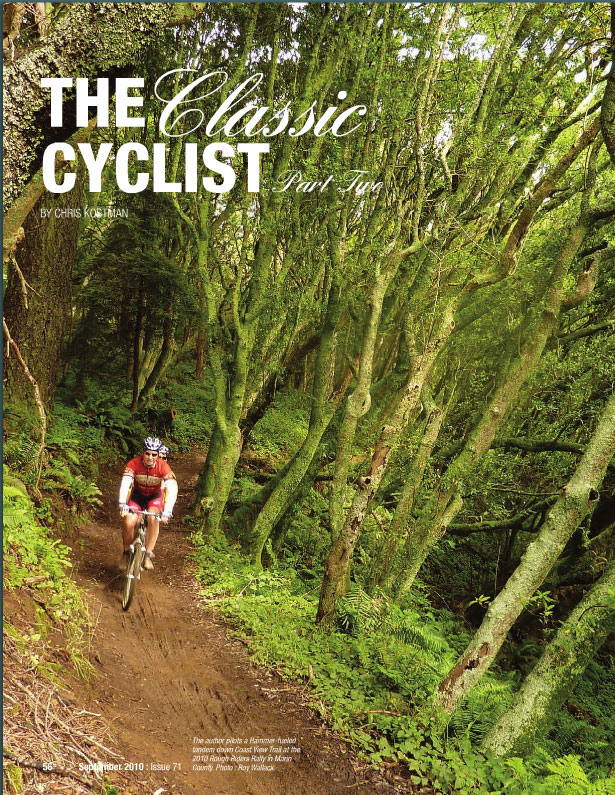The Classic Cyclist, Part TwoBy Chris KostmanOriginally published in Endurance News, #71, August/September 2010. Download that publication here (80 pages; 4.5MB). View this article on the Hammer Nutrition website: Click. Part one of this article. | Part three of this article. | Part four of this article. | Read and comment upon this article on Chris' Rough Riders blog. Image of the author above by Roy Wallack, from the 2010 Rough Riders Rally As I explained in part one of this article, Road Cyclists entering the sport over the past fifteen or so years tend to come in by way of mountain biking, triathlon, or fitness, rather than pure road cycling. As a result, most of these “cyclists” lack the knowledge which makes up the foundation of the classic cyclists’ repertoire and which builds upon the backbone of the sport. Continuing with the theme initiated in part one of this article, here are some more things the classic cyclist knows and does: FOR THE LOVE OF THE SPORT The classic cyclist rides first and foremost for the pure love of cycling, for the fun and enjoyment that comes from bonding with a simple, beautiful, and ingenious mechanical device and ranging the world. This cyclist rides for the wind in the hair, for the sensation of hot, cold, humid, wet, or dry on the skin, for carving up rolling terrain like riding a roller coaster, for the sensations of a pounding heart, sweaty brow, and heaving chest. The pursuit of adventure, camaraderie, and well-being astride a wheel are the primary driving forces behind every ride. “Training” is reserved only for preparing for specific competitive, or personal challenge, efforts; it is but rarely the motive for heading out onto the road. MENTORSHIP The classic cyclist learned skills and etiquette from other classic cyclists, usually one or two masters in particular who took the time to encourage and enlighten the neophyte. Over time, the neophyte also becomes a mentor, passing along knowledge, wisdom, and specific tricks of the trade through specific instructions and by example. Cyclists are not born knowing how to trim a front derailleur, how to quickly clip in while starting on a steep grade, how to scan through the back windows of cars for drivers about to open their doors, or how to ride deep in the drops with a straight spine and relaxed shoulders. Mentors imbue new cyclists with these and many other pearls of wisdom, coaxing them along their journey to mastery. EMBRACES MOTHER NATURE The classic cyclist embraces the whole panorama of weather that Mother Nature provides and doesn’t shirk from riding in less-than-ideal conditions, nor cut a ride short just because the weather takes a turn for “the worse.” Au contraire, the classic cyclist relishes the opportunity to feel more alive and at one with the environment because of dramatic weather. Whether rain, cold, snow, heat, or headwinds, it is all respected without judgment as “just weather being weather.” Riding only on sunny weekend mornings in the same matching “kit” on the same route every week does not suit the classic cyclist. CLEAN STEED, SELF-SERVICED The classic cyclist keeps her steed clean and free of unnecessary add-ons. No more than one gadget is attached to the bike, the handlebar tape is clean (and preferably white), there are no garish colors nor logos, and the entire “ensemble” of the bike itself is understated, simple, and stylish. The classic cyclist also maintains the steed herself, keeps it finely tuned, and knows how to make adjustments on the road. For example, she routinely amazes other cyclists by reaching down to make a rear derailleur adjustment on another’s bike while stopped at a light: a quick flick of the wrist restores that bike’s drivetrain to purring perfection. This deep understanding of the workings of the bicycle allow the classic cyclist to repair, or make work-arounds, for any mechanical mishap encountered on the road. As well, a proper seat pack with a comprehensive multi-tool, two tubes, patch kit, and a small but specific selection of “ride-savers” keeps the show on the road for her and others. Phoning for a ride home is anathema to the classic cyclist. RIDES TO THE RIDE The classic cyclist acknowledges that the primary point of cycling is to cycle, and specifically not to pollute nor clog the roads with a motor vehicle. Thusly, driving to a ride start is avoided whenever possible. Tacking an extra ten or thirty miles onto any given ride, in order to transit to and from the ride meet-up spot, is a given; these “bonus miles” are appreciated as an opportunity to warm up properly, find a groove, and start or finish any given outing with the proper classic style and mindset.
|
|
 |
 |


